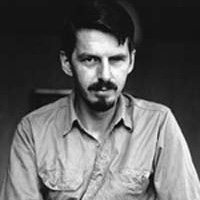I Know a Man by Robert Creeley: Summary and Critical Analysis
The Speaker of this poem is caught between two conflicting positions: whether to solve his existential despair by escaping from the world by buying a goddamn big car or by paying a greater attention to what is immediately in front of him. The speaker is suffering from the darkness and he wants to escape from it, this darkness has been created for him due to the capitalist and materialistic world. Although he tries to escape from it he has to get the help from the same capitalist production car, which he pronounces goddamn.

Robert Creeley (1926-2005)
Throughout the poem he is suffering from identity crisis, and his struggle is for identity. The burden is so heavy upon him that he can’t take the other side of the possibilities. The speaker is frustrated therefore seeks an escape. And he also knows that escaping is not only solution because it has to be purposeful and goal oriented which is not possible in this materialistic world. The poem is in minimalist technique (Laconic technique) which speaks in minimum and presents maximum ideas.
The poem 'I Know a Man' by Robert Creeley is a poem on the postmodern problem of identity crisis and loss of direction in the life of the modern Americans. This poem perfectly illustrates the interconnections between the traditional sense of the void and failure of communication. The spacer’s generalized angst here actually intensifies the horror of the void. His vague speech gives us nothing concrete to hold on and instead further broadens the gap between human subjectivity and the world with which it must come to terms. The protagonist becomes the passive and helpless victim of his own powers of speech, and his failure is most clearly portrayed when he utters and octosyllabic line. “I Know a Man” is also concerned with an essential human problem: how to cast light on the darkness which surrounds us, how to “run order through chaos,” as Henry Adams put it. The poem contains three different alternatives to this problematic state. The first is prompted by the narrator: “buy a goddamn big car”. The poem hints here at the silliness of the way most of Creeley’s contemporaries in the United States deal with the problems they encounter – by buying something.
The opening lines plunge into what appears to be an ongoing dialogue. Although there is a suggestion that the poem is part of a conversation, it is also a version of an inner dialogue in which dual components of the poet’s psyche are involved. The proposal to “buy a goddamn big car” links the philosophical with the physical; and the bold proposition to do something is both a specific possibility and a figure for choosing to take action. This admonition to retain an awareness of direction while acting reinforces the initial division in consciousness. Such abbreviations as “sd”, “yr” and “s” help to carry the tension of the speaker’s voice throughout. The poem is in consonance with the compact nature of the speech as it moves from an arresting hesitancy to impulsive action. The absence of metaphor, form, meter, rhyme, figurative language and other familiar technical devices place the total burden of meaning of world placement alone. The language is suggestive of the painting-like expression of the speaker; the words like “sd” indicate that the speaker is breathless. The stresses without unstressed syllables between them and the unnatural pauses communicate both the speaker’s anxious restraint and his needs for release, well before he states his problems. The unexpected break in “the darkness surrounds us” sounding as if the speaker was almost suffocating or breathless with fear and forced to inhale mid-word conveys his heightened panic.
“I know a man” is a poem of the decade about a world gone out of control. “Creeley has spoken of the “senses of confusion and muddiness and opaqueness that people obviously feel in their lives.” The admonition to “look out where yr going” is part of a recognition by the “friend” that the impulse to act is very human and must be respected, but that this type of spasmodic action does not really accomplish much. The poet is aware that he is “always talking” to combat the darkness, whether his voice is inner or externally directed but he also knows that he is committed to an ultimately inexact solution. The speaker is caught between two conflicting positions: whether to solve his existential despair by escaping from the world or by paying a greater attention to what is immediately in from of him. Despite the poem’s title he cannot truly know anyone- either himself or another – because he is constantly talking and thus avoiding recognition of the others. He does not really know the other’s name, nor is he able to differentiate himself from his interlocutor. The ancient symbols of light and darkness are comprehensive in human nature and express the human struggle – between life and death, knowledge and ignorance, good and evil – for survival, enlightenment, and salvation.
Cite this Page!
Shrestha, Roma. "I Know a Man by Robert Creeley: Summary and Critical Analysis." BachelorandMaster, 17 Nov. 2013, bachelorandmaster.com/britishandamericanpoetry/i-know-a-man.html.
